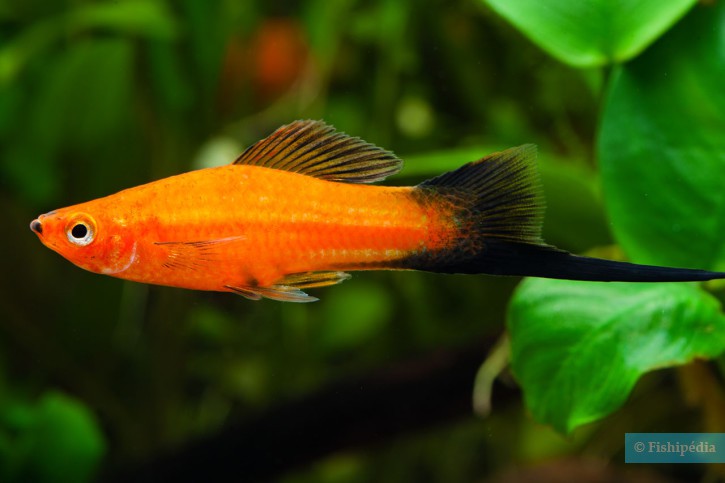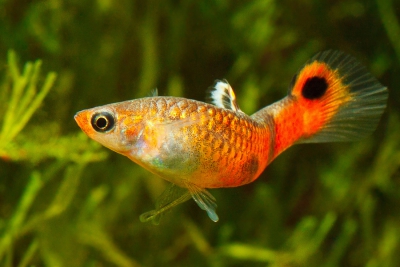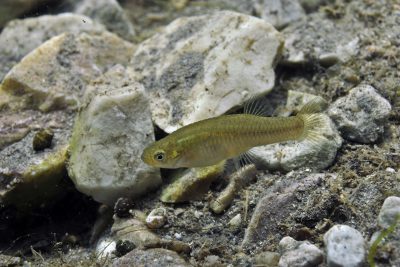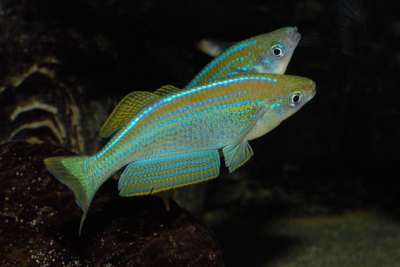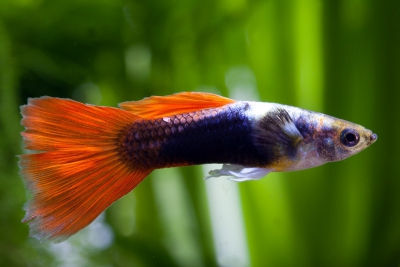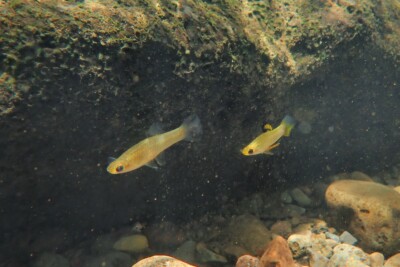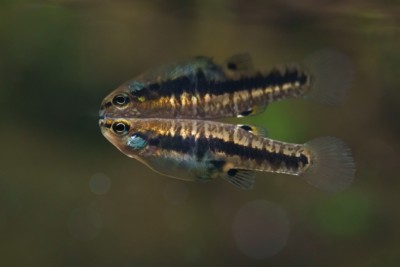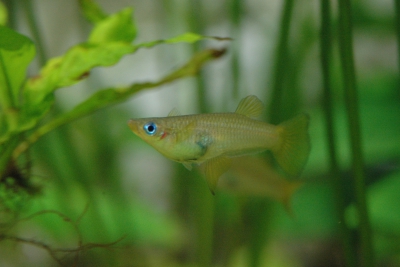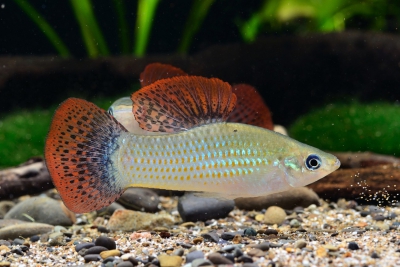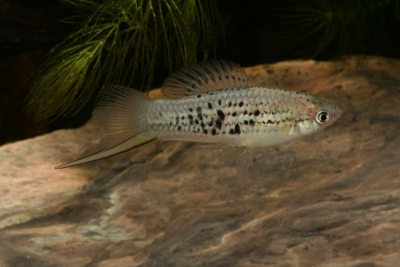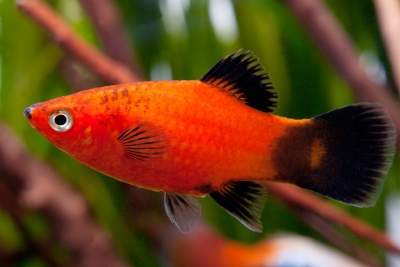green swordtail
| Family | Poeciliidae |
|---|---|
| Genus | Xiphophorus |
| IUCN category (World) | LC |
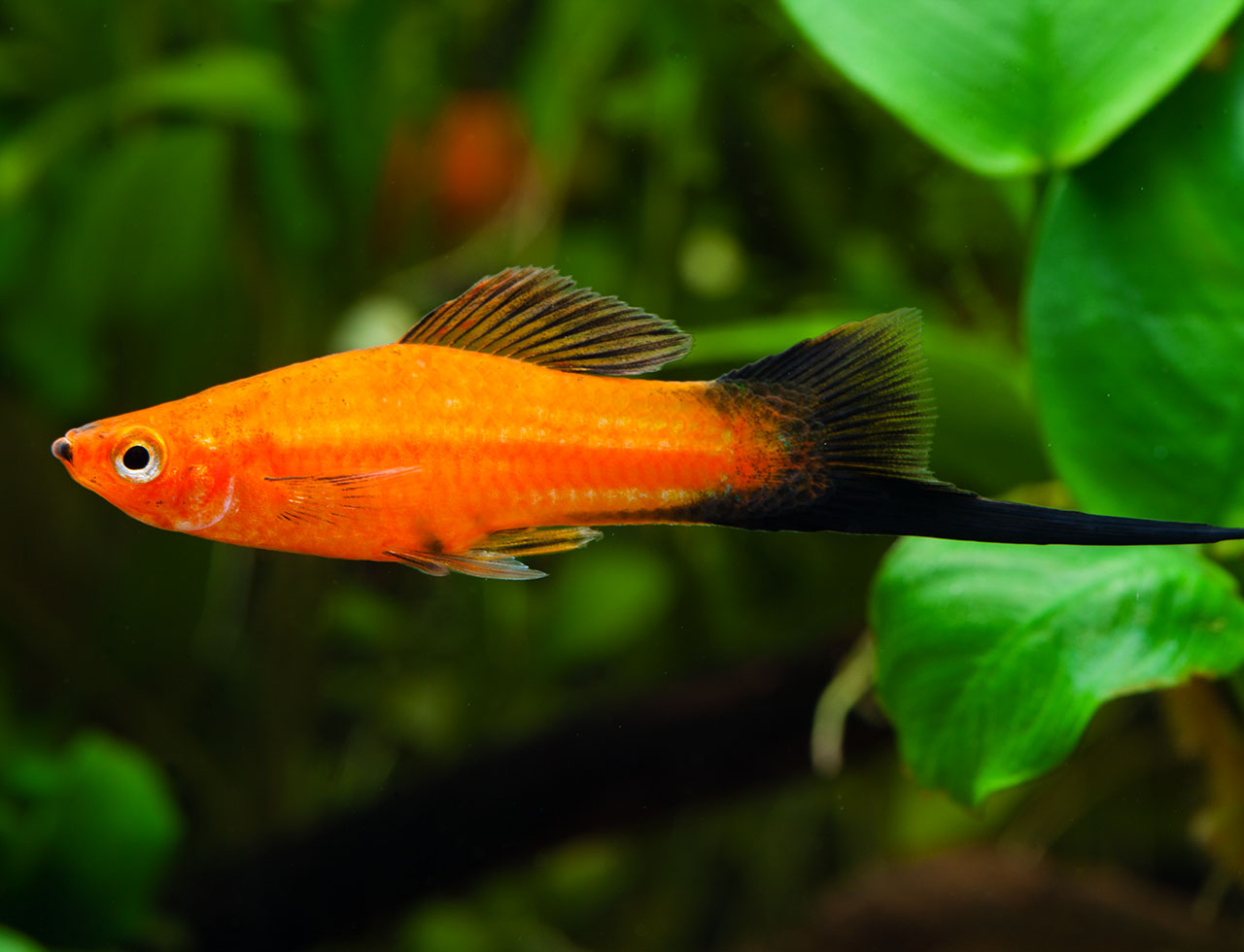

Introduction
Xiphophorus hellerii, commonly known as green swordtail, is a fresh water fish from the Central America.
This sheet is currently being prepared. The texts currently proposed come from our data model or are being drafted. To request priority for this content, you can write to us HERE.
Who is it?
Genus Xiphophorus
Species of the genus Xiphophorus are mainly found along the Atlantic coast of Mexico, Belize, and Central America. In 2019, 28 species were recorded in FishBase. These fish are found over a range of about 2,200 km.
Some species inhabit very limited areas, for example in a single lake, while others are endemic to an entire basin. This is particularly true in the Mexican Transvolcanic Belt, where the genus has evolved into various taxa. Conversely, some species have a very wide distribution range.
There are four monophyletic groups: the platy and swordtail groups north of the Mexican Transvolcanic Axis, and the helleri and clemenciae groups to the south. The status of the three species found on the southern plateaus remains unresolved, and the phylogenetic relationships between the different groups are not yet fully understood. Natural hybridizations do occur, but they remain rare.
All belong to the group of livebearers, like all members of the Poeciliidae family.
Morphology
-
Type
-
Average size10 cm
-
Maximum size15 cm
-
Longevity5 year
-
Type
-
Average size10 cm
-
Maximum size15 cm
-
Longevity5 year
How to recognize This fish ?
The green swordtail measures between 10 and 15 cm.
Behaviour & Life cycle
-
dietomnivorous
-
Sociabilityliving in small groups
-
territorialNo
-
Way of livingdiurnal
The green swordtail is a fish living in small groups naturally found at mid-depth. This species is omnivorous .
n general, this species does not care much about other animals crossing its path.
Reproduction
-
Reproductionovovivipare
-
PolygamyYes
The green swordtail is a fish ovovivipare. In this species, the dominant males are polygamous and reproduce each season with several females.
Harmless species
This species does not represent any particular threats to humans when encountered in its natural environment.
Origin and distribution
What is its habitat?
Natural environment characteristics
-
Temperature21 - 26 °C
-
pH (acidity)7 - 8
-
gh (hardness)10 - 15
-
FlowMedium and Slow
Biotope presentation
The green swordtail is most often found at a depth between 0m and 1m. However, it is not impossible to find this species at other depths. This animal evolves in areas characterized by a strong presence of vegetation (aquatic and marsh plants, decaying organic matter, roots...).
Main recommendations for fishkeeping
Deontology
In order to preserve wildlife, if you acquire this animal, it must not be released into the wild. See also, the Fishipedia charter.
Fishipedia supports the practice of responsible and environmentally friendly aquarium keeping. We encourage maintenance if it is motivated by a desire to understand the biological functioning of living things and if it is done with respect for animal life.
We believe that aquaristics is an opening to the discovery of aquatic environments, especially freshwater, and that this knowledge is necessary to better protect and respect these environments. Logically, we refute the compulsive purchase of animals that would not find a sufficient and / or adapted place in the host aquarium.
Our recommendations
-
Min volume120 liters
-
Population min6
-
Temperature21 - 26 °C
-
pH (acidity)6.8 - 7.2
Characteristics
-
Difficulty breedingvery easy
-
Robustnessrobust
-
Behaviourpeaceful
-
Availabilityusual
Recommended equipment from our partners
-
Aquarium
-
Filtration
General reminders
It is strongly advised to read the complete dedicated file and to get information on the feedbacks of maintenance of the envisaged animal, this to avoid any potential conflict whose end result is generally the death of the individual (or the other inhabitants). It is important not to overload your aquarium to limit pollution. This will make maintenance easier.
In nature, animals are subject to weather conditions and live in waters with variable characteristics. The recommendations offered by our team for aquarium maintenance are a guidance and cannot be assimilated to scientific datas.
General reminder on maintenance datas
Le démarrage d'un aquarium est une partie primordiale pour l'équilibre et le bien-être des poissons. Lorsque l'on met en eau un aquarium, l'eau passe naturellement par un cycle biologique : le cycle de l'azote. Celui-ci dure environ trois semaines. Tous les 2 jours, nous vous conseillons de tester votre eau jusqu'à ce que le taux de nitrite soit à zéro pendant plusieurs jours d'affilée.
Pour accélérer ce cycle, vous pouvez utiliser un activateur de bactéries comme JBL Denitrol. Cette solution riche en bactéries vivantes et enzymes permet une mise en place rapide du cycle de l'azote. Les poissons peuvent alors être introduits plus rapidement.
Il est important de tester l'eau de son aquarium régulièrement pour maintenir un environnement sain pour les poissons et les autres habitants. Les tests d'eau permettent de mesurer les niveaux de différents paramètres tels que le pH, la dureté totale, ainsi que les taux de nitrates, de nitrites et d'ammoniaque.
Pour réaliser ces tests, vous pouvez utiliser des produits d'analyse spécialisés tels que JBL ProScan qui permet de réaliser un diagnostic de l'eau directement via un smartphone. Il existe également des coffrets de tests plus classiques de bandelettes, comme JBL PROAQUATEST.
En cas d’usage de l’eau du robinet, vous pouvez utiliser un conditionneur d’eau de type Biotopol de JBL pour éliminer les substances nocives comme le chlore, le cuivre, le plomb et le zinc. Une eau trop dure ou trop calcaire peut être inadaptée à de nombreuses espèces tropicales d’eau douce. Si nécessaire, vous pouvez la couper avec de l’eau osmosée ou de pluie filtrée afin d’obtenir une dureté plus adaptée aux besoins de vos poissons et de vos plantes. Les conditionneurs d'eau garantissent une meilleure santé aux poissons et une meilleure croissance des plantes.
Chlorine and chloramine are dangerous for the health of animals. Used to disinfect water, these agents are present in significant quantities in tap water. We recommend using an anti-chlorine agent every time you change the water. In addition to chlorine, treatments and medicines sold for aquarium use sometimes contain dangerous heavy metals in high doses.
Specific needs for the green swordtail
The green swordtail is a species which lives naturally at a temperature between 21 °C and 26 °C. Nitrate levels should remain below 50mg/L. To keep the water clean and unpolluted, plan on changing 20% to 30% of the water volume each month.
The green swordtail is a species that is very accessible to breed. Its hardiness makes it an ideal animal for a first time aquarist. However, it is recommended that you follow a few basic rules for successful breeding.
This species is particularly common in the aquarium trade. Animals from long-term breeding are usually acclimatized at a temperature of about 26 °C in neutral water.
Cohabitation & Environment
Being a living in small groups fish, it is advisable to install at least 6 individuals in an aquarium of 120 liters minimum (for 80 cm of frontage). Group maintenance is a prerequisite to ensure their well-being. Lonely individuals tend to quickly become stressed and become especially susceptible to disease. Although sometimes certain groups can "merge", mixing several gregarious species living in the same zone of life is not recommended if the volume is not consequent.
The green swordtail is a peaceful species that generally does not exhibit behavioral problems in a community aquarium.
This fish being polygamous, the male must always be maintained with several females. A ratio of three females to one male seems to be a good compromise for the constitution of the group.
Males have the particularity to be particularly oppressive with females. This behavior can tire the females to the point that it sometimes leads to their death. It is important to set up a planted aquarium with many refuges.
The species enjoys a particularly vegetation-rich environment. The addition of plants will provide many useful hiding places for resting. These areas are also conducive to possible breeding in the aquarium.
Tips for feeding
The green swordtail is omnivorous.
This species can eat dry food (flakes, pellets), fresh food and frozen food. To avoid deficiencies, it is recommended to vary the types of food.
Feed animals in moderation to maintain good water quality. Meals should be eaten within 2–3 minutes, served in several small portions rather than a single large ration.
Uneaten food quickly decomposes, releasing ammonia, nitrites, and nitrates, which disturb the aquarium’s biological balance.
Make sure each species can access food properly, slower or bottom-dwelling individuals may require targeted feeding.Food recommendations from our partner JBL - Products PRONOVO
-
Granules
-
Flakes
Reproduction protocol
-
Maintenance difficultyvery easy
-
egg-laying protectionNo
Reproduction of this species in an aquarium is considered very easy. Ideally, it takes place at a temperature of around 26 ° C for a pH of 7.5 .
Hybridization risks
In general, it is advised not to mix several species of the same genus or different varieties of the same species, to avoid the risks of hybridization.
These plants might interest you
Plants play a crucial role in aquariums, both for their ability to filter water by absorbing excess nutrients and for their aesthetic contribution. They provide fish with natural hiding places, can serve as breeding sites, and generally help maintain the overall balance and optimal conditions of the aquarium. The selection presented here includes species from the same regions as the species described on this page, although they do not necessarily come from its exact natural biotope.
To go further
Sources & Contributions
Participation & Validation
The Fishipedia team and specialist contributors are committed to providing high-quality content. However, although the information comes from scientific sources or testimonials from specialists, the cards may contain inaccuracies.

Patrick Chartrer

Benoit Chartrer
Translation
Translation done with the valuable contribution of our translators, who make this information available to a wider audience. We sincerely thank them for their commitment.
Bibliographic references
- - GBIF
- - Distribution of Freshwater Alien Animal Species in Morocco: Current Knowledge and Management Issues - Abdelkhaleq Fouzi Taybi - Youness Mabrouk - Christophe Piscart - Diversity - 2023. 15, 169
- - Biological Invasions in South Africa - Brian W. van Wilgen - John Measey - David M. Richardson - John R. Wilson - Tsungai A. Zengeya - Springer Nature - 2020. ISBN 978-3-030-32393-6
- - Alien and invasive freshwater fish species in Iran: Diversity, environmental impacts and management - Hamid Reza ESMAEILI - Azad TEIMORI - Feridon OWFI - Keivan ABBASI - Brian W. COAD - Iranian Journal of Ichthyology - 2014.
- - First Report of Xiphophorus maculatus (Günther) (Southern Platyfish) and Confirmation of Poecilia reticulata (Peters) (Guppy) from Guadeloupe-France - Zachariah D. Alley - Kayla M. Fast - Jeremy Delolme - Michael W. Sandel - Caribbean Naturalist - 2023.
- - First Record of a Feral Population of Green Swordtail (Xiphophorus hellerii) with an Additional Record of Guppy (Poecilia reticulata) in Turkish Freshwaters - Şerife Gülsün Kırankaya - F. Güler Ekmekçi - Hacettepe Journal of Biology and Chemistry - 2021.
- - Any colour you like: new records of ornamental livebearers (Poeciliidae: Cyprinodontiformes) from freshwaters of Argentina. - Guillermo E. Terán - Stefan Koerber - Juan Carlos Stazzonelli - Gastón Aguilera - J. Marcos Mirande - Ichthyological Contributions of PecesCriollos - 2022. - ISSN 1868-3703
- - Female preference for swords in Xiphophorus helleri reflects a bias for large apparent size - GIL G. ROSENTHAL - CHRISTOPHER S. EVANS - The National Academy of Sciences - 1998.
- - First confirmed record of an established population of green swordtail (Xiphophorus hellerii Heckel, 1848) in Europe - Pencho Pandakov - Zhivko Barzov - Radoslav Moldovanski - Helena Huđek - Knowl. Manag. Aquat. Ecosyst. - 2021. 422, 31
- - Biology and invasive potential of the introduced swordtail Xiphophorus hellerii Heckel (Poeciliidae) in Western Australia - M. G. MADDERN - H. S. GILL - D. L. MORGAN - John Wiley & Sons - 2011. AQUATIC CONSERVATION: MARINE AND FRESHWATER ECOSYSTEMS
Scientific partners
Tags
Species of the same family
Same genus
